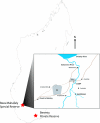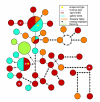Incongruence between genetic and morphological diversity in Microcebus griseorufus of Beza Mahafaly
- PMID: 17109740
- PMCID: PMC1657033
- DOI: 10.1186/1471-2148-6-98
Incongruence between genetic and morphological diversity in Microcebus griseorufus of Beza Mahafaly
Abstract
Background: The past decade has seen a remarkable increase in the number of recognized mouse lemur species (genus Microcebus). As recently as 1994, only two species of mouse lemur were recognized according to the rules of zoological nomenclature. That number has now climbed to as many as fifteen proposed species. Indeed, increases in recognized species diversity have also characterized other nocturnal primates--galagos, sportive lemurs, and tarsiers. Presumably, the movement relates more to a previous lack of information than it does to any recent proclivity for taxonomic splitting. Due to their nocturnal habits, one can hypothesize that mouse lemurs will show only minimal variation in pelage coloration as such variation should be inconsequential for the purposes of mate and/or species recognition. Even so, current species descriptions for nocturnal strepsirrhines place a good deal of emphasis on relatively fine distinctions in pelage coloration.
Results: Here, we report results from a multi-year study of mouse lemur populations from Beza Mahafaly in southern Madagascar. On the basis of morphological and pelage variation, we initially hypothesized the presence of up to three species of mouse lemurs occurring sympatrically at this locality, one of which appeared to be undescribed. Genetic analysis reveals definitively, however, that all three color morphs belong to a single recognized species, Microcebus griseorufus. Indeed, in some cases, the three color morphs can be characterized by identical mitochondrial haplotypes.
Conclusion: Given these results, we conclude that investigators should always proceed with caution when using a single data source to identify novel species. A synthetic approach that combines morphological, genetic, geographic, and ecological data is most likely to reveal the true nature of species diversity.
Figures




References
-
- Ambrose L. Three acoustic forms of Allen's galago (Primates; Galagonidae) in the Central African region. Primates. 2003;44:25–39. - PubMed
-
- Anderson MJ, Ambrose L, Bearder SK, Dixson AF, Pullen S. Intraspecific variation in the vocalizations and hand pad morphology of southern lesser bush babies (Galago moholi): A comparison with G. senegalensis. Int J Primatol. 2000;21:537–555. doi: 10.1023/A:1005400205038. - DOI
-
- Groves CP, The genus Cheirogaleus Unrecognized biodiversity in dwarf lemurs. Int J Primatol. 2000;21:943–962. doi: 10.1023/A:1005559012637. - DOI
-
- Niemitz C. Vocal communication of two tarsier species (Tarsius bancanus and Tarsius spectrum) In: Niemitz C, Stuttgart Fischer, editor. Biology of Tarsiers. 1994. pp. 129–141.
Publication types
MeSH terms
LinkOut - more resources
Full Text Sources
Research Materials
Miscellaneous

